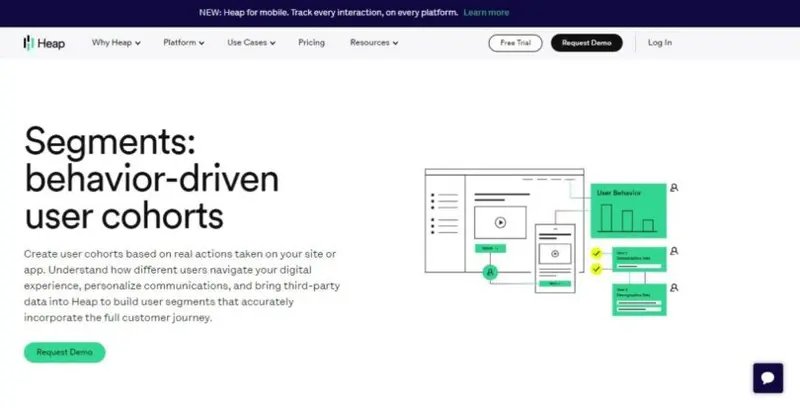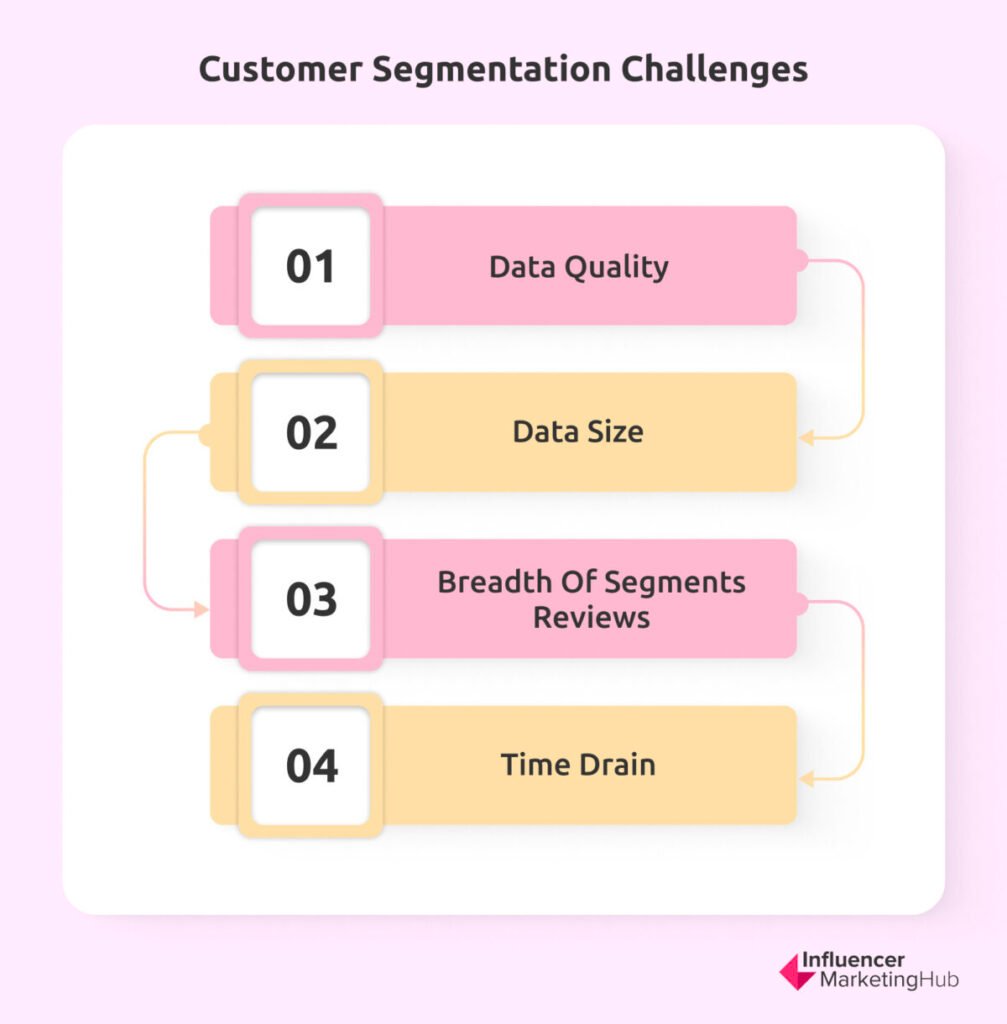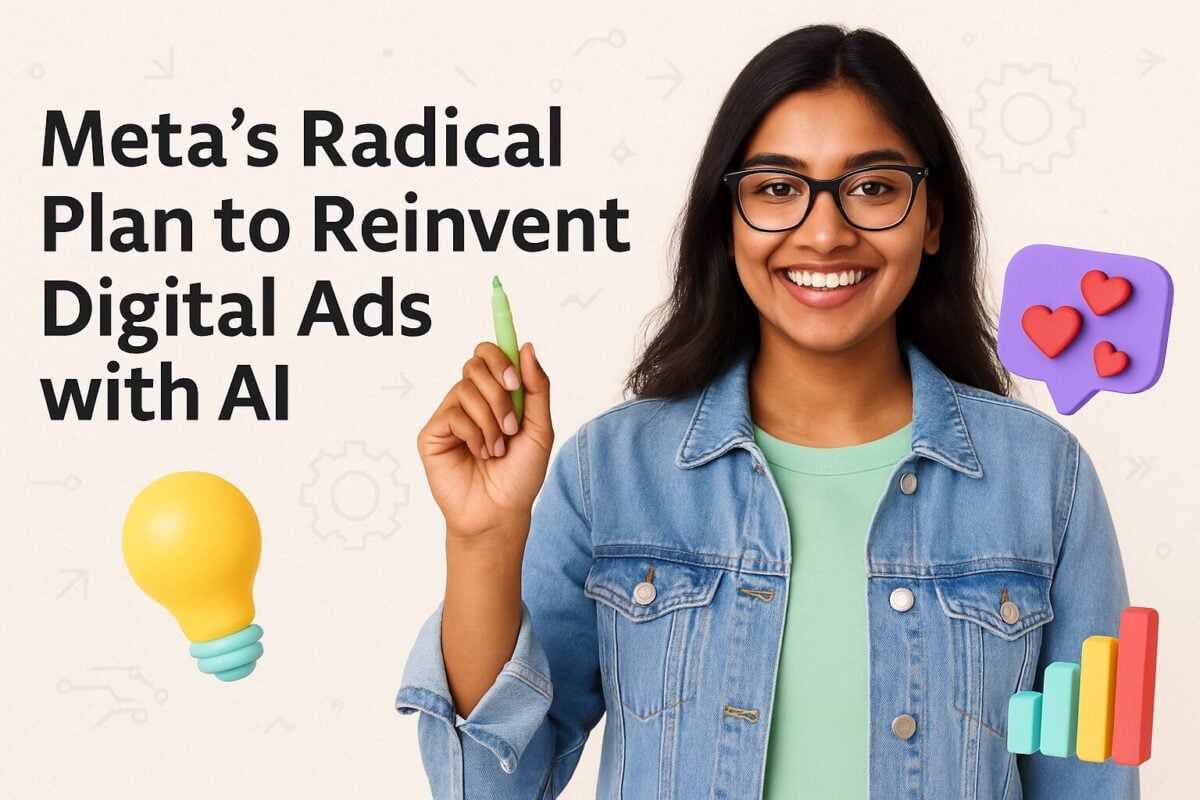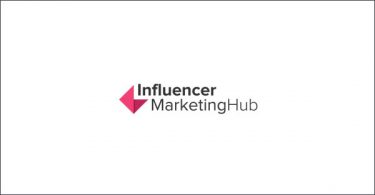To personalize communication and experiences in marketing, you must know and provide what's relevant to your target market. Although some businesses focus on one customer type, brands catering to various types must segment their client base to create optimal experiences for each one. In fact, applying segmentation to email campaigns results in an open rate that’s 14.31% higher than non-segmented messages.
Customer segmentation divides clients into groups according to their shared traits, such as geographic location, age, and whether or not they've bought your product or sought your service. You need a way to discover these groupings and how each segment interacts with your business.
In short, the segmentation process starts with data that you consider most useful for your marketing campaigns. It also involves tools that analyze and group customers based on these common behaviors and characteristics.
AI-powered solutions offer the analytics and insights necessary to help you craft unique messages and value propositions that will suit your market's needs, desires, and preferences on a large scale.
4 Challenges in Customer Segmentation
These 4 issues can make customer segmentation difficult without the help of software tools:
1. Data quality
You can only segment your customers properly when your database contains accurate data. Tools are necessary to identify duplicate, obsolete (outdated records), ambiguous (due to wrong spelling, tagging/categorization methods, or misleading column headings), or hidden data (saved data not shared by other departments).
2. Data size
You must gather enough data to identify your customers' motivations and behavior. They can come from multiple sources, such as surveys, feedback forms, and analytics. Collecting and organizing data from all your content distribution channels is difficult without AI tools. On the other hand, using this technology can provide you with new opportunities such as segments you haven't reached out to in the past, allowing you to adjust your marketing efforts accordingly.
3. Breadth of segments
Segmentation that is too narrow or too broad might lead to the misinterpretation of data insights and poor targeting for marketing campaigns. Effective segmentation enables you to reach out to groups with confirmed buying power, and AI solutions help by featuring pre-set and customizable categories or segments.
4. Time drain
Data analysis and customer profile creation take time. Moreover, you also need to make time to identify the channels to help you connect with your segments. You can get almost instant results through AI segmentation platforms that automate these processes.
Features to Look for in an AI Customer Segmentation Tool
The best AI-driven customer segmentation platforms should offer these functionalities:
Organization
AI segmentation tools serve as the master repository of all your customer data. It should provide you with a unified picture of who your clients are, the reasons why they do business with you, and what they like about your marketing efforts.
Visualization and report distribution
Segmentation platforms generate reports with visually appealing charts and graphs, helping you understand analytics and insights better than a spreadsheet. Moreover, the tools allow you to share these static or dynamic reports.
Customization
Segmentation solutions enable you to use a metric across different segments. If your net promoter score declines, the AI tool must be able to point you to the least happy customers in various categories, such as age group, subscription plan, or product purchased.
Scalability
Segmentation AI can scale, automatically collating information from new customers or subscribers whether they come in trickles or surges. An increase in clients may lead to new customer segments, which most likely opens up new niche reporting.
8 Best AI Segmentation Platforms
1. Peak.ai

Peak.ai uses headless segmentation, which doesn’t depend on a single source. Receiving data from as many data touchpoints as possible empowers you to get a more holistic customer profile, including information such as their shopping habits and likelihood to churn. Moreover, when you pair this historical data with AI, you can predict what product your customers will buy next or when they’re most likely to open their next email.
The platform ingests and organizes vast amounts of data into a single source of customer truth. It then classifies client data into segment maps according to non-predictive and predictive attributes and explores critical metrics in each segment. You can select from over 35 AI-driven attributes, including purchase and lifetime value to churn propensity.
Peak.ai lets you link these data segments to your customer-facing systems, such as social media, customer relationship management systems (CRMs), or customer data platforms (CDPs). 80% of the platform’s applications are pre-built while 20% are configurable to your business workflows and rules.
2. Optimove

Optimove is a cross-channel campaign management and customer development platform, which integrates information from four sources to provide users with a customized predictive customer model. These sources are first-party raw data, third-party data, in-app or on-site user activity, and campaign response history.
In Optimove, segmentation happens through customer clustering analysis or using mathematical models to discover groups of similar customers that are as homogenous—with the least or smallest variation among customers—as possible in each group. The platform uses demographics, behavior patterns, and real-time activities to segment customers into micro-segments that refresh daily.
At the same time, marketers can customize segments for analysis or campaign marketing using any field without using micro-segmentation. Optimove’s built-in marketing optimization bot, Optibot, combs through data per one or more segments to identify trends and actionable insights. Moreover, the platform achieves more in-depth segmentation by tracking customers as they move from one micro-segment to another. This shift acknowledges behaviors throughout the customer’s life cycle.
3. Visual Website Optimizer (VWO)

VWO is primarily a point-and-click split-testing tool that allows you to measure the impact of various experiments—across different segments—to optimize your website. Its integrations let you export these segments into your CRM and client engagement platforms.
VWO Data360 collects customer data across many touchpoints and aggregates them into holistic individual profiles that your entire team can access from one place for planning experiments. Data360 can segment your customer info based on diverse datasets: visitor attributes captured from your customer’s browser (language, location, pages per session, device, operating system, and more), visitor events (activities on your website), behavioral data via heatmaps and survey responses using VWO Insights, and experimentation data (response to A/B tests) using VWO Testing.
Meanwhile, VWO Personalize records your website visitors’ behavior—from their first visit to their first purchase—helping you create hyper-customized journeys that improve retention.
4. Clearbit

Clearbit is a data enrichment software recommended for B2B marketing as it allows you to segment accounts—individual and corporate customers—according to over 100 attributes. They include employee count, location, contact information, revenue, technologies installed, and others. Marketers can define segments using these data points to match their ideal customer profile (ICP) for targeted engagement.
Furthermore, Clearbit’s internet provider intelligence, Reveal, lets its users know when these “best-fit” companies show intent, such as reading product reviews or visiting your pricing page.
This machine learning-powered tool uses public and private data sources to collect, sort, and verify first and third-party data. Clearbit then uses verified data to update existing or new company records and correct outdated or incomplete ones in real-time. You can also tap the platform’s dataset of 350 million contacts and 44 million companies to find new ideal customers.
5. Heap

Heap is another platform that uses session replay to reveal and analyze how your customers interact with your website or app. Also, this tool’s Illuminate data science layer helps you uncover the effort it takes for your site or app users to accomplish a transaction and what events cause friction or lead to conversion and retention.
Heap refers to customer segments as “user cohorts,” which you can create based on their online behavioral patterns—from first touch to adoption—no matter their marketing channel starting point. You can view segments based on page views, media plays, uploads, data entry, or social shares and determine which steps contribute to your company’s goals and revenue.
The analysis can help you prioritize efforts in maximizing these behaviors or modifying your product or strategy. The outcome can include adding or improving features on your site or app or making a new offer to personalize the user experience.
6. BlastPoint

BlastPoint is a customer intelligence tool that uses data-rich, predictive customer segmentation. You can create as many segments as you need by filtering and sorting customers from any dataset in your system. The platform’s visualizations—which are customizable, depending on the attributes your campaign needs—allow you to understand your client’s characteristics and motivations better. You can also get insights on the micro-level with BlastPoint’s Profile View, which shows how each customer compares to the average.
BlastPoint has high-quality external customer data, which you can integrate with your dataset to glean insights on demographics, media or social channel consumption, and behavioral and psychographic information. This data enrichment process sets the stage for data clustering, based on your goals. You arrive at target segments once the AI displays the clusters with the highest propensity or likelihood of fulfilling your business goals, from adopting new technology to paying overdue bills.
7. Graphite Note

Graphite Note uses AI to equip sales and marketing teams with more than historical customer data from surveys and transaction records. The platform’s machine learning algorithms automate the detection of behavioral patterns and insight generation that are part of creating segments. These patterns help identify your most valuable customers, those who have stopped doing business with you, and clients’ pain points with your particular product or service.
A no-code ML and data storytelling platform, Graphite Note uses visualizations to help your team understand the insights gleaned from segmentation. From there, you can connect your datasets with the tool’s predefined templates to generate predictions for each segment.
8. FullStory

FullStory dubs itself as a digital experience intelligence platform, giving you a preview of general or individual visitor behavior on your website through Autocapture. This feature logs all user actions on your website or app—clicks, scrolls, and highlights—which reveals trends over time.
You can view “autocaptured” behavior through session replay (a timeline of actions per visit) or heatmaps (visual representation of most or least-clicked webpage elements). Autocapture covers dead and rage (repeated clicking of a webpage or app element due to frustration) clicks, enabling you to identify areas for user interface improvement.
You can create segments based on various event or behavior criteria, such as the number of visitors browsing on mobile, using a new feature, converting from free to paid accounts, or completing customer journeys. FullStory can also track various usage metrics to determine the factors correlated with loyal or churn customers.
Use Customer Segmentation for Laser-Focused Content Marketing
Segmenting your customers is a necessary step for the success of every marketing campaign. The good news is customer segmentation is also a basic CDP feature, so you can start with these customer data solutions if you're not ready to use AI.
Meanwhile, if you're interested in discovering how AI can figure into your entire marketing strategy, read about our Top 29 AI Tools for Marketers in 2025 and Top 18 AI-Powered Influencer Marketing Platforms for Brands & Agencies.
Frequently Asked Questions
What is customer segmentation?
Customer segmentation is the process of dividing a customer base into distinct groups based on shared characteristics such as demographics, behaviors, or preferences, allowing for targeted marketing strategies.
How does AI enhance customer segmentation?
AI enhances customer segmentation by automating data analysis, identifying patterns, and creating dynamic segments based on real-time data, which improves accuracy and personalization in marketing efforts.
What are some popular AI tools for customer segmentation?
Popular AI tools for customer segmentation include Peak.ai, Optimove, Visual Website Optimizer (VWO), Clearbit, Heap, BlastPoint, Graphite Note, FullStory, Insight7, and Amazon Personalize.
What features should I look for in an AI customer segmentation tool?
Key features to look for include data organization capabilities, visualization and reporting tools, customization options, scalability, and real-time data analysis.
What challenges can arise when implementing AI for customer segmentation?
Challenges include ensuring data quality, managing data size, avoiding overly broad or narrow segments, and the time required for data analysis. Additionally, ethical considerations regarding customer data privacy must be addressed.
How can AI tools help predict customer behavior?
AI tools use predictive analytics to analyze historical data and forecast future customer behaviors, enabling businesses to anticipate needs, reduce churn, and improve customer retention strategies.




